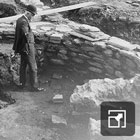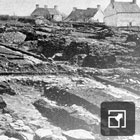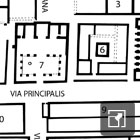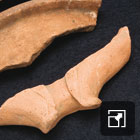Uncovering the Past
The names of the fields had always given a clue to the former use of the area alongside Church Road – Gaer Fawr and Gaer Fach. Coins and bits of pottery had also been found for centuries, but it wasn’t until Rev TJ Jones, the Rector of Gelligaer, met with the Cardiff Naturalist Society when they visited Llancaiach Fawr in 1894 that people took the possibility of a hidden Roman development seriously.
After fund raising, the first digs started in 1899, continuing until 1913. Archaeology was a very new science and the dig was lead by interested business men who supervised paid workmen. Over the years they uncovered the structure of the fort, including the Granaries, the Defences and Gatehouses, the Commander’s House and the annex containing the Baths. They also identified the site of the Parade Ground, a pottery kiln and the site of Roman burials. The digging was hard work, and the site soon became known as “the Water Works” as it seemed to rain incessantly!
All the results were documented by John Ward, who was then the Curator of the Municipal Museum and Art Gallery in Cardiff. However, some of the best records are the brilliant black & white photographs taken by Arthur Wright, a local school master. The images show how the digs became a fascination for people – many visited and there were even reports in The Times.
In 1963 there was an excavation of the earlier timber fort on an adjoining field, and even in the last decade there have been geophysical surveys of this area.
Now the site is an Ancient Scheduled Monument, and no digging or surveying can be undertaken without permission. The field with the main fort is in private ownership, where horses are often seen running. You can walk across the field and pick up the lumps and bumps that indicate where some of the hidden walls lie.
New interpretation has been installed alongside Church Road, and from here you can gain an impression of how imposing this fort would have looked on this hill top.





